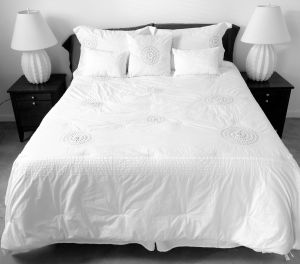In recent years, bed bugs have become a serious public health concern. In 2011 and 2012, some of the most severe outbreaks occurred in New York City, Philadelphia and Detroit. What is most notable about these outbreaks is that they occured in unexpected placeslike the New York City office of the United Nations and the Lincoln Center . Many of the high profile locations deny accusations of bed bugs, while others acknowledge that although there are bed bugs on their premises, it does not indicate uncleanliness. Along this line of thought, the fear that bed bugs are a sign of personal untidiness complicates resolving the issue further. In fact, many people either delay their reports of bed bugs for fear it may suggest their homes are unclean. This begs the question: do bed bugs truly arise from uncleanliness?
The belief that unclean environments cause bed bug infestations is inaccurate. Bed bugs are attracted not to dirt, but rather to warm spaces, carbon dioxide, and blood. The barely macroscopic creatures (1mm-7mm) thrive in such environments, especially when there are a given space offers many hiding spaces such as those found in homes. Often, these bugs will enter the home by attaching themselves to an item of clothing while an individual is outdoors, such as in a school or theater. Once they have entered the home, it may take some time to immediately realize the presence of an infestation.
Although bed bugs feed on blood during the night, they are not shy-they can be visible during all hours of the day. One of the most visible indications of a bed bug infestation is seeing the creatures in various parts of the house as tiny, dark brown/reddish bugs along with their dark excrement in beds, sofas, and enclosed spaces round the home. In addition to seeing them, many people experience their nightly bites. However, not everyone shows signs of bed bug bites—some people will have minor to no symptoms, while others may exhibit more visible, sometimes allergic reactions. Particularly in the latter case, it is essential to seek medical attention to manage the health issues presented by the infestation. Despite their parasitic presence, and aside from the potential to cause an allergic reaction in some individuals, bed bugs do not transfer disease while they feed on their host.
Of course, the instinct of every resident has is to identify the means of removing the intruders from the home. As it happens, bed bugs removal efforts benefit greatly from an expert hand. They are resistant to many pesticides, including DDT. The treatment process can include the application of a high heat treatment, which would involve heating the area in question as high as, but not limited to 117 degrees for one hour . In some cases, using insect spray can help, although as previously mentioned, they have acquired resistance to many pesticides. This is one among other treatments used to treat bed bugs. To identify the best method of treating bed bugs in a specific situation, get in touch with a professional who handles bed bug extermination.
In 2012, San Francisco passed rigorous measures identifying bed bugs as a public health problem, and establishing guidelines for managing infestations. The guidelines require that tenants inform their landlords of a bed bug problem. Next, landlords are required to hire a pest control company to perform an inspection verifying the infestation, and proceed with an extermination procedure of the bed bugs. Six weeks following, the San Francisco Health Inspectors are then required to verify that there has been no resurgence of the infestation. In addition to actively removing an infestation, San Francisco’s measures address preemptive inspections to make sure that bed bugs are not found in residents’ units.
Continue Reading ›
 San Francisco Injury Lawyer Blog
San Francisco Injury Lawyer Blog






 Our San Francisco tenant’s law firm believes that all San Francisco’s residents, whether they own or rent and whether they are very rich or struggling to make ends meet, deserve a safe and habitable residence. A lawsuit currently pending in San Francisco Superior Court and discussed in a
Our San Francisco tenant’s law firm believes that all San Francisco’s residents, whether they own or rent and whether they are very rich or struggling to make ends meet, deserve a safe and habitable residence. A lawsuit currently pending in San Francisco Superior Court and discussed in a  Bedbugs Generally
Bedbugs Generally A group of tenants in Rancho Cordova banded together to form a class and the
A group of tenants in Rancho Cordova banded together to form a class and the